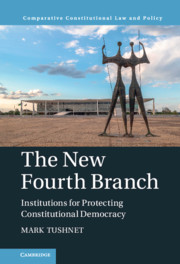Book contents
- The New Fourth Branch
- Comparative Constitutional Law and Policy
- The New Fourth Branch
- Copyright page
- Contents
- Acknowledgments
- 1 Introduction
- 2 Why a Fourth Branch?
- 3 Why a Fourth Branch?
- 4 Design Issues in General
- 5 Design Principles in Practice
- 6 Anti-corruption Investigations
- 7 Electoral Commissions
- 8 Audit Agencies
- 9 Conclusion
- Index
7 - Electoral Commissions
Case Studies from India, the United States, and South Korea
Published online by Cambridge University Press: 20 August 2021
- The New Fourth Branch
- Comparative Constitutional Law and Policy
- The New Fourth Branch
- Copyright page
- Contents
- Acknowledgments
- 1 Introduction
- 2 Why a Fourth Branch?
- 3 Why a Fourth Branch?
- 4 Design Issues in General
- 5 Design Principles in Practice
- 6 Anti-corruption Investigations
- 7 Electoral Commissions
- 8 Audit Agencies
- 9 Conclusion
- Index
Summary
Malaysia 2018. From independence in 1957 until recently, Malaysia was a “competitive authoritarian” state whose political system was dominated by an alliance known since the 1970s as the Barisan National (BN). The BN controlled all national political institutions, including the national Election Commission. The Commission determines district boundaries and supervises the conduct of elections. By the early 2010s, the BN’s dominance was fraying because of internal divisions and the increasing consolidation of a single opposition group.
- Type
- Chapter
- Information
- The New Fourth BranchInstitutions for Protecting Constitutional Democracy, pp. 123 - 157Publisher: Cambridge University PressPrint publication year: 2021
- 2
- Cited by

